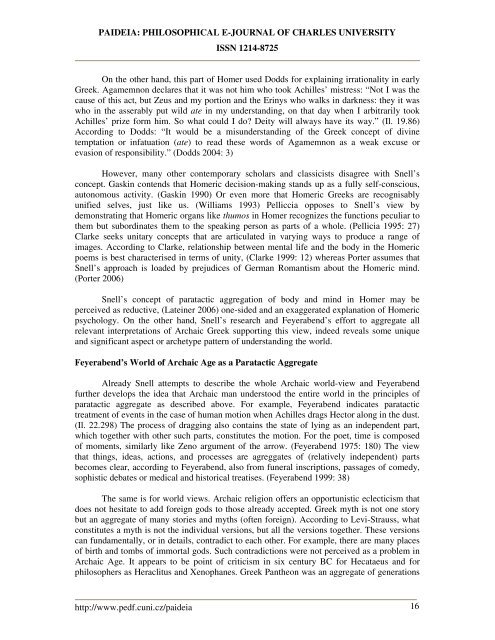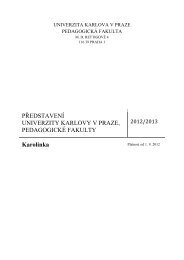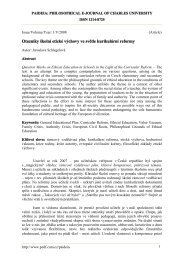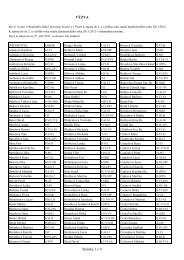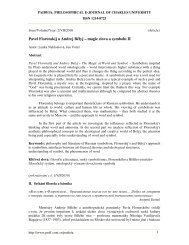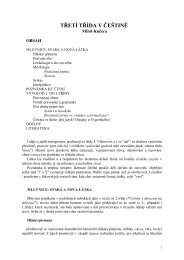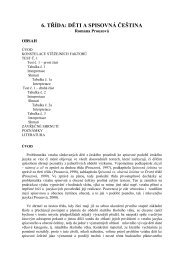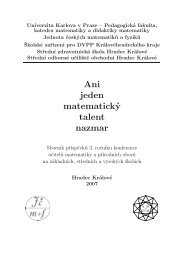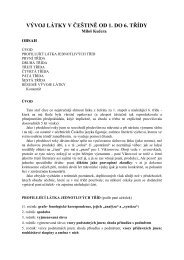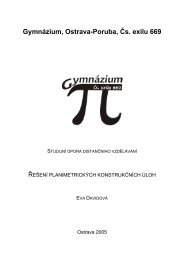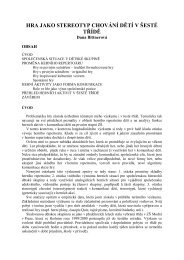Feyerabend's interpretation of Archaic Age
Feyerabend's interpretation of Archaic Age
Feyerabend's interpretation of Archaic Age
Create successful ePaper yourself
Turn your PDF publications into a flip-book with our unique Google optimized e-Paper software.
PAIDEIA: PHILOSOPHICAL E-JOURNAL OF CHARLES UNIVERSITYISSN 1214-8725On the other hand, this part <strong>of</strong> Homer used Dodds for explaining irrationality in earlyGreek. Agamemnon declares that it was not him who took Achilles’ mistress: “Not I was thecause <strong>of</strong> this act, but Zeus and my portion and the Erinys who walks in darkness: they it waswho in the asserably put wild ate in my understanding, on that day when I arbitrarily tookAchilles’ prize form him. So what could I do? Deity will always have its way.” (Il. 19.86)According to Dodds: “It would be a misunderstanding <strong>of</strong> the Greek concept <strong>of</strong> divinetemptation or infatuation (ate) to read these words <strong>of</strong> Agamemnon as a weak excuse orevasion <strong>of</strong> responsibility.” (Dodds 2004: 3)However, many other contemporary scholars and classicists disagree with Snell’sconcept. Gaskin contends that Homeric decision-making stands up as a fully self-conscious,autonomous activity. (Gaskin 1990) Or even more that Homeric Greeks are recognisablyunified selves, just like us. (Williams 1993) Pelliccia opposes to Snell’s view bydemonstrating that Homeric organs like thumos in Homer recognizes the functions peculiar tothem but subordinates them to the speaking person as parts <strong>of</strong> a whole. (Pellicia 1995: 27)Clarke seeks unitary concepts that are articulated in varying ways to produce a range <strong>of</strong>images. According to Clarke, relationship between mental life and the body in the Homericpoems is best characterised in terms <strong>of</strong> unity, (Clarke 1999: 12) whereas Porter assumes thatSnell’s approach is loaded by prejudices <strong>of</strong> German Romantism about the Homeric mind.(Porter 2006)Snell’s concept <strong>of</strong> paratactic aggregation <strong>of</strong> body and mind in Homer may beperceived as reductive, (Lateiner 2006) one-sided and an exaggerated explanation <strong>of</strong> Homericpsychology. On the other hand, Snell’s research and Feyerabend’s effort to aggregate allrelevant <strong>interpretation</strong>s <strong>of</strong> <strong>Archaic</strong> Greek supporting this view, indeed reveals some uniqueand significant aspect or archetype pattern <strong>of</strong> understanding the world.Feyerabend’s World <strong>of</strong> <strong>Archaic</strong> <strong>Age</strong> as a Paratactic AggregateAlready Snell attempts to describe the whole <strong>Archaic</strong> world-view and Feyerabendfurther develops the idea that <strong>Archaic</strong> man understood the entire world in the principles <strong>of</strong>paratactic aggregate as described above. For example, Feyerabend indicates paratactictreatment <strong>of</strong> events in the case <strong>of</strong> human motion when Achilles drags Hector along in the dust.(Il. 22.298) The process <strong>of</strong> dragging also contains the state <strong>of</strong> lying as an independent part,which together with other such parts, constitutes the motion. For the poet, time is composed<strong>of</strong> moments, similarly like Zeno argument <strong>of</strong> the arrow. (Feyerabend 1975: 180) The viewthat things, ideas, actions, and processes are agreggates <strong>of</strong> (relatively independent) partsbecomes clear, according to Feyerabend, also from funeral inscriptions, passages <strong>of</strong> comedy,sophistic debates or medical and historical treatises. (Feyerabend 1999: 38)The same is for world views. <strong>Archaic</strong> religion <strong>of</strong>fers an opportunistic eclecticism thatdoes not hesitate to add foreign gods to those already accepted. Greek myth is not one storybut an aggregate <strong>of</strong> many stories and myths (<strong>of</strong>ten foreign). According to Levi-Strauss, whatconstitutes a myth is not the individual versions, but all the versions together. These versionscan fundamentally, or in details, contradict to each other. For example, there are many places<strong>of</strong> birth and tombs <strong>of</strong> immortal gods. Such contradictions were not perceived as a problem in<strong>Archaic</strong> <strong>Age</strong>. It appears to be point <strong>of</strong> criticism in six century BC for Hecataeus and forphilosophers as Heraclitus and Xenophanes. Greek Pantheon was an aggregate <strong>of</strong> generationshttp://www.pedf.cuni.cz/paideia 16


